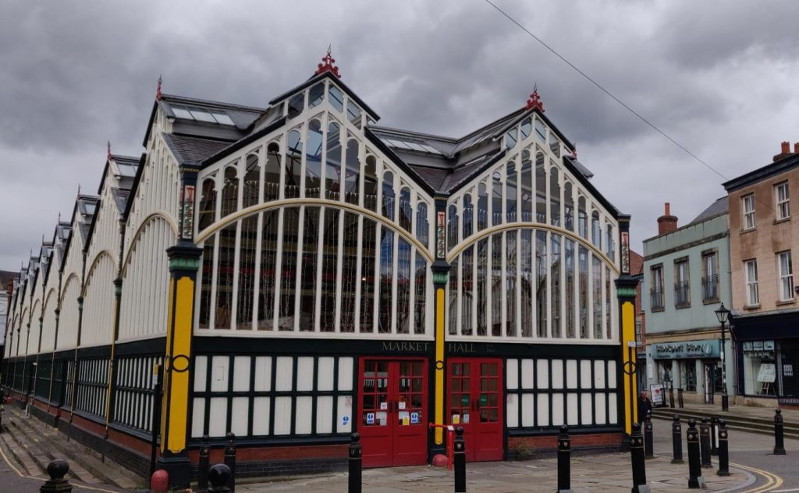
10 Oct A place management tour of the north west
I’ve been spending a lot of time in the north west this year. I know the region well having grown up there and worked in Manchester early in my career. Now based in London, I have been used to returning for quick weekends to see family or for events but often haven’t had the time to stay much longer.
Since starting The Institute of Place Management’s MSc Place Management & Leadership Programme in January this year at Manchester Metropolitan University, I now build in time around the residential sessions to get out and about with my place management hat on and take a fresh look at new and familiar places. On a recent trip, we managed to fit in quite a few!

Stockport Market Hall
I started my visit in Stockport, meeting with fellow MSc student and Manchester-based colleague Esther Morrison. Esther founded Foodie Friday in 2013 and really connects with the town, its heritage and its people. Having experienced Foodie Friday in June under blue skies and blazing sunshine (go, if you haven’t been!) it was interesting to see Stockport’s Old Town on a day when the market hall was shut and there wasn’t an event.
With Esther as my expert guide, we met some of the newest businesses in the Old Town, looked at current development sites, mused over sites for potential green spaces or sustainable food projects and got a real sense of how people are trying to make things happen at street level.
The town (like many) is challenged by an aging shopping centre that dominates people’s perceptions and a lack of footfall with the majority of offices located away from the Market Place. The Old Town has so much potential and it really uses Stockport’s tricky topography!
It’s great to see these new independent businesses opening and people working together to revive it. With the recent consultation on Stockport Town Centre West and a mayoral development corporation being created to steer it, the town will be a place to watch over the next five years.

Rochdale Market Hall
Having previously been to Bury and the fabulous market with Esther, this time we headed for Rochdale, who has recently been shortlisted in the Rising Star category of the Great British High Street Awards.
The town hall square is a grand civic centre that is Grade I listed and a Heritage Action Zone. A recently created market hall and views of the newly exposed River Roch has really changed the streetscape. The café in the new indoor market has panoramic views across the town yet it is now on the verge of closure.
Behind this grand square, the public realm was dated with several shopping centres although there are exciting new developments coming including Rochdale Riverside.
The location of the town is stunning with surrounding countryside views and great transport, which implies there is a great opportunity here. Hopefully, the BID, working with other partners will get the support and vision that it needs to realise the potential of the town centre and its market.
Next, I headed off to Liverpool and its surrounding region.

Southport Market Hall
First stop was an old favourite Southport, a coastal town that seems to be going through hard times and had an air of sadness about it. There are lots of regeneration projects in the pipeline following recent funding announcements and the market hall is being reimagined as part food hall. Southport has grand Victorian architecture with wide streets and a lot of shop units and shopping arcades that now sit empty. There is an arts centre ’The Atkinson’, which seems well used but the town is quite disjointed, as often you visit the seafront and skip the shops and town centre completely. On a Sunday, a lot of things were closed.

Wavertree High Street, Liverpool
Back in Liverpool, I met with Love Wavertree, a grassroots organisation that has achieved amazing things in a few short months. Their work includes closing the road for Car Free Day last month with a programme of activities free for all. While the street has its challenges in terms of traffic, retail mix and a number of large gaps, with the weight of the community behind it, this is a high street that has the chance to really change how it’s perceived and used and they are already planning what they do next.
I am a frequent visitor to Prescot and have watched with interest as the town centre has developed. It could be considered a ‘Tesco Town’ yet the town centre has held up well with a historic pedestrianised street with a market place and church at one end. With a large retail park and Knowsley Safari Park on its doorstep, it’s easy to bypass the town centre if you are driving.

Prescot Town Centre, near Liverpool
However, there have been steady improvements over the past five years in the form of restored shop fronts (via Prescot Townscape Heritage Initiative), new businesses moving in and now with the development of the Shakespeare North Playhouse underway, the changes are coming thick and fast. There seems to be a genuine partnership in place between Knowsley Council and the local businesses, working together in the best interests of the town. There are public realm improvements underway (nice paving!), new restaurants (including Pinon – which featured in a recent TV documentary) and the town has just won a prize in the form of Christmas Lights which will hopefully entice people from the surrounding areas to go and spend an evening there.
So, what we can take away from seeing so many places over a short period of time? Well, much as one size does not fit all when it comes to town centres and high streets, there are commonalities around the issues facing most of these places.
Declining footfall (except Prescot) at different times of day. Places might be busy in the day but have no evening economy or vice versa – what can be done to ensure balanced footfall?
Aging shopping centres – having once anchored town centres, many of them now disrupt the opportunity for redevelopment – how can we overcome this?
Strange opening hours, for example, an arts centre and market that don’t open on a Sunday and reduced pub and restaurant hours on some days with no consistency
Markets – Southport has lots of signage for the ‘Market Quarter’ yet it doesn’t exist in reality, which can be confusing. Markets are not always the answer (see food halls too) and need to be a component of the town centre offer rather than standalone
‘Clone towns’ in relation to the abundance of larger retailers. When they make up the bulk of the town’s shopping offer, they leave large holes behind when they are gone and these vacant units are unlikely to be relet as retail
First impressions count! When arriving at a train/metro station or by bus, there is often no sense of where you are, why you should have come, or what you’re there to do!
The dominance of cars. Whilst we appreciate that public transport is not great across the (northwest) region, it does mean that the car dominates. There have been decades of discussion about sorting out the trains – it should be possible to live/work between Leeds, Manchester, and Liverpool as they are not far apart but unfortunately the infrastructure isn’t there. Perhaps with the current consultation to bring buses under public control in Manchester, there is the hope of change coming
Ownership. There are often added complications around establishing ownership and finding landlords to relet or sell property and planning for change of use making it difficult to adapt to the town centre offer
Having established these commonalities, what can be done about them? The Institute of Place Management (IPM) has identified the top 25 priorities for places wanting to increase footfall. They aren’t rocket science, meaning they can be applied to most places to make improvements fast. Some of these include:
Consistent activity hours – Many of the places we visited had inconsistent opening hours that didn’t seem aligned to anything in particular and certainly not to other amenities in the town
Improving appearance and signage – By improving the main entry points and signposting, the town centre can help people feel like they made the right decision by going there. Also, consider what the pavement and road surface looks like
Considering your retail and service offer – Can you influence these in your area? What can you reuse empty units for? Can you identify the landlords? Or can they be used as pop-ups/ Meanwhile use in the interim period?
Collaborating – Inform your networks including local academic institutions and councils of your plans. Are there partners locally, who can help you reactivate empty units to provide support to start-ups, or are you eligible for funding?
Place marketing – Southport had some lovely, vintage style branded products in The Atkinson shop but it wasn’t clear if this was just for the shop or part of the town’s identity. Think about what your place stands for and how this can be translated into a brand and/or marketing strategy
Seating – Can visitors stop and sit when they want to, not just in a café but benches in the town centre? In some places, there are squares with no seats at all making them devoid of life
Finally, really think (with an outsider’s hat on if it’s your place), why people should use it or visit. Is it still a shopping destination like Liverpool and Manchester? Or a leisure hangout known for its good food, weekly market or local heritage? Without understanding this it is difficult for places to thrive. If you don’t know the answer, look for data to guide you or run a consultation to acquire the data (it can be fun and informal, not just surveys) to find out more about how people use the town, where they are going for things that aren’t there and what they would like to change (or perhaps it’s great as it is?)
I’m currently in Manchester and Liverpool on a monthly basis, and Esther is based in the northwest). We would love to hear your thoughts on where else we should re/visit? Are you doing interesting things in your place that you’d like to show others or get some help with? Get in touch and share what you are doing?

